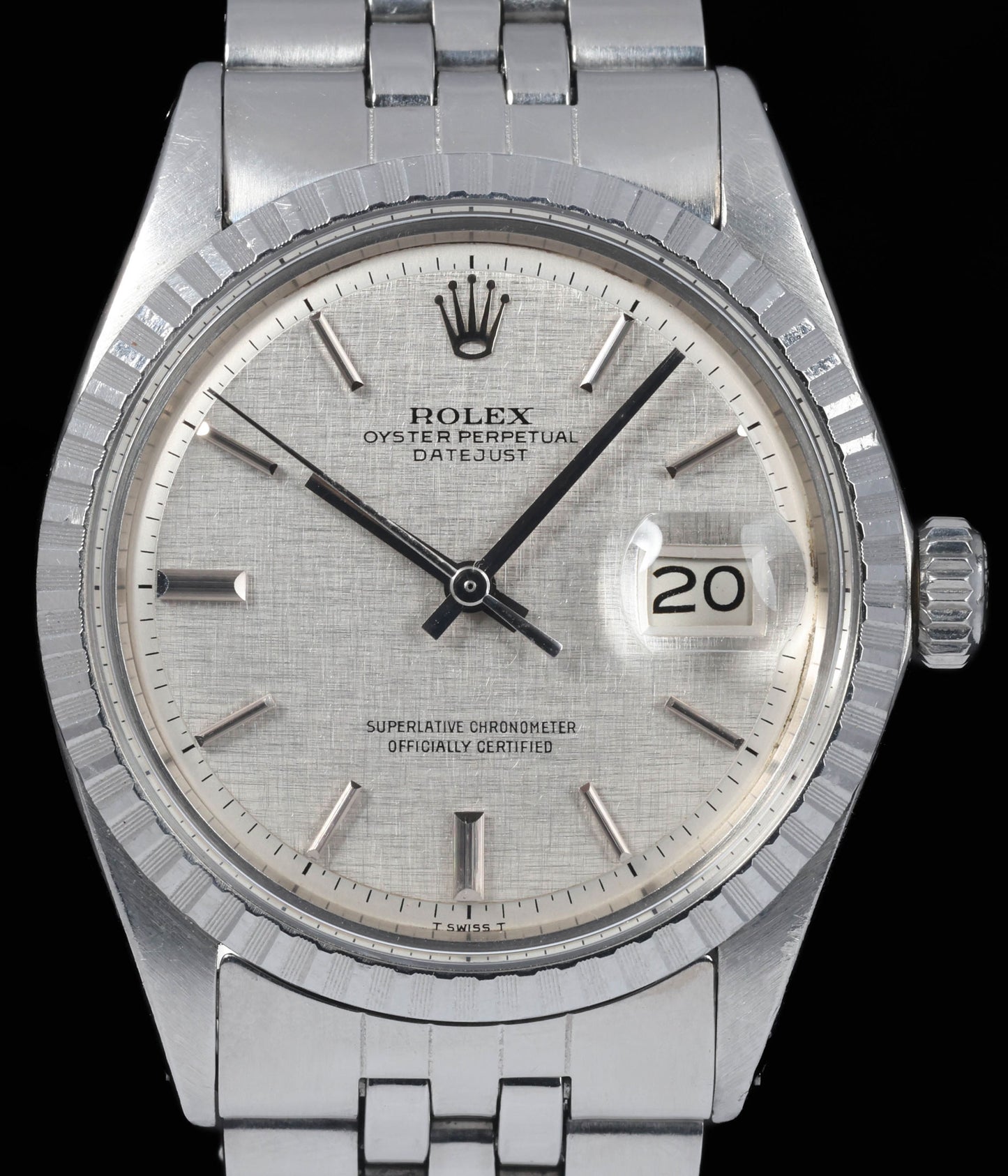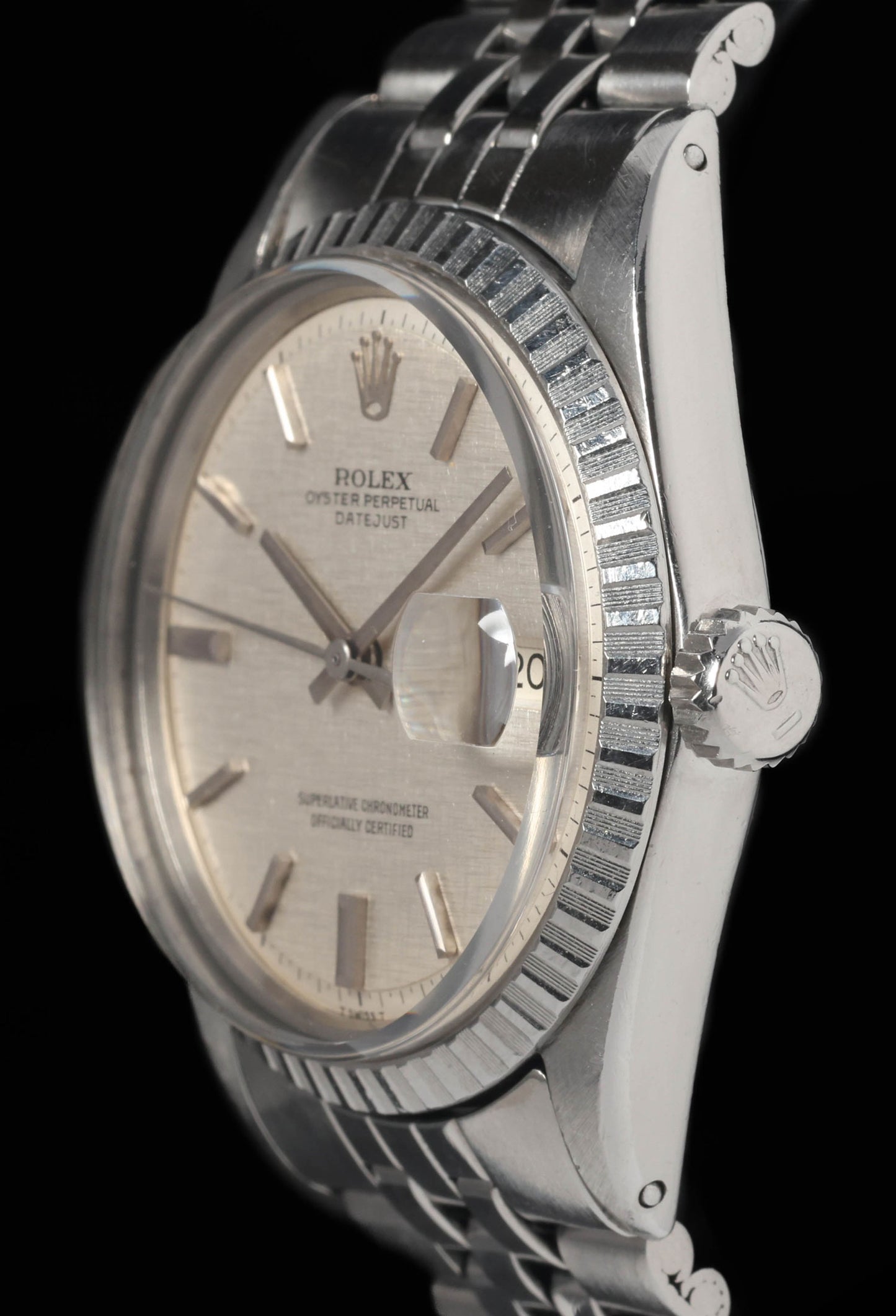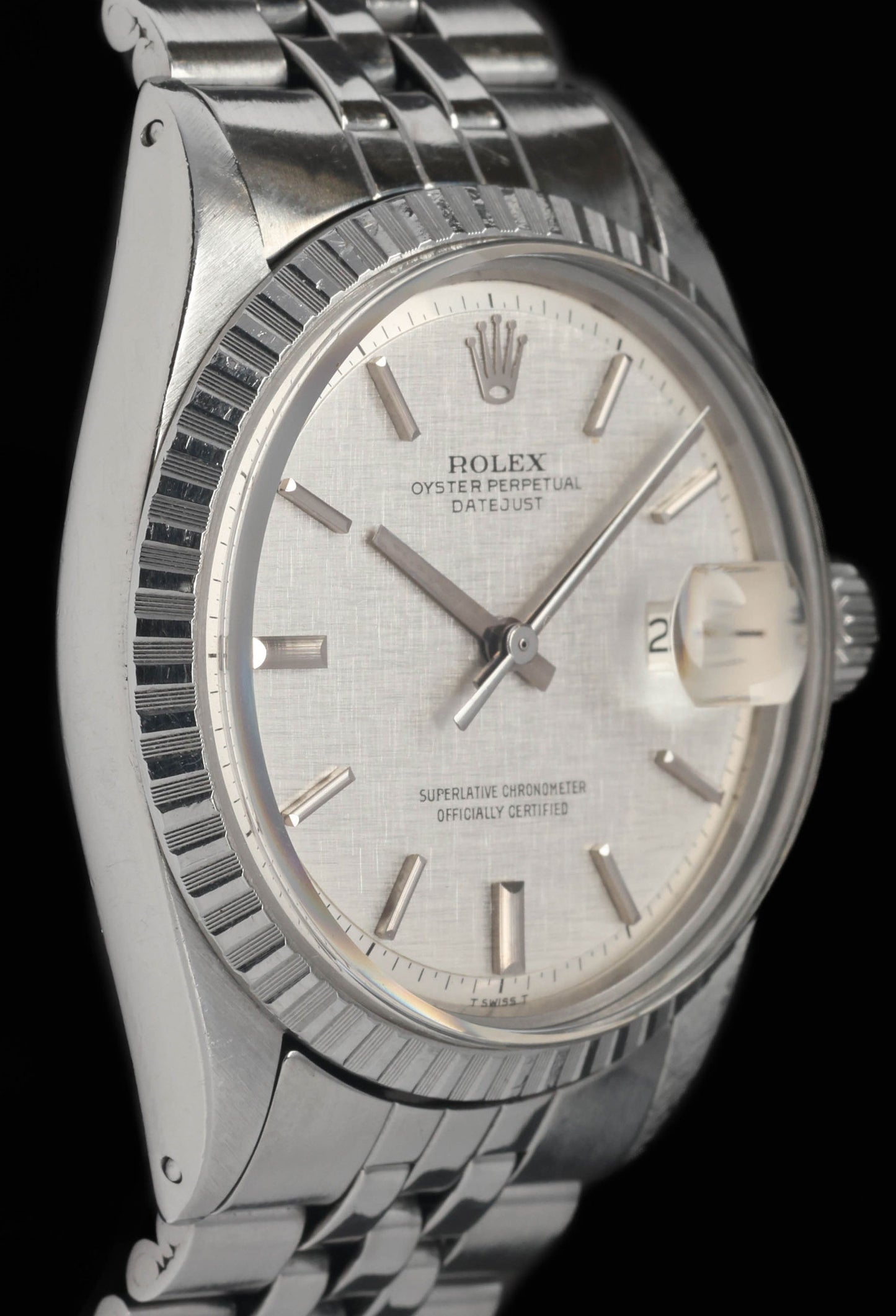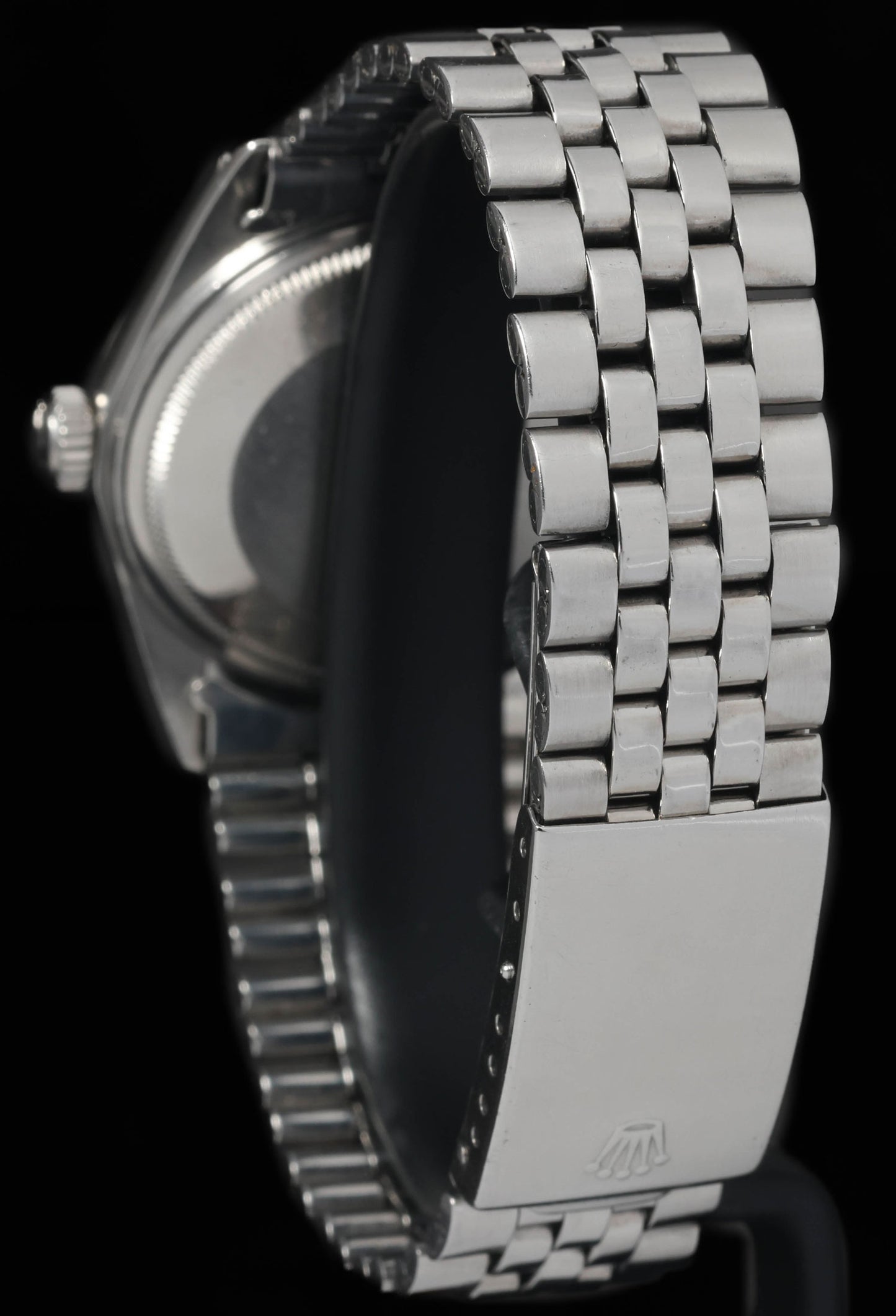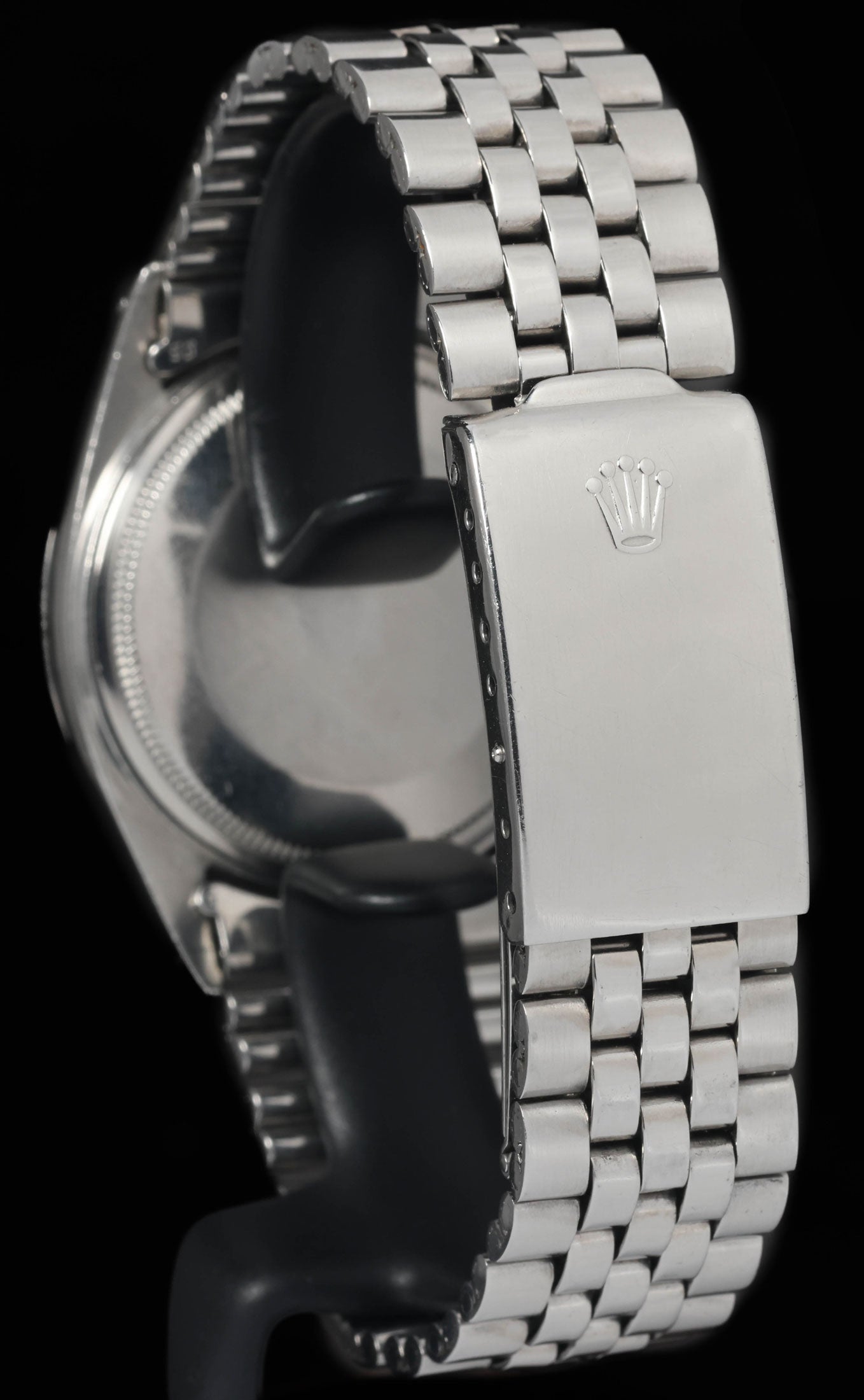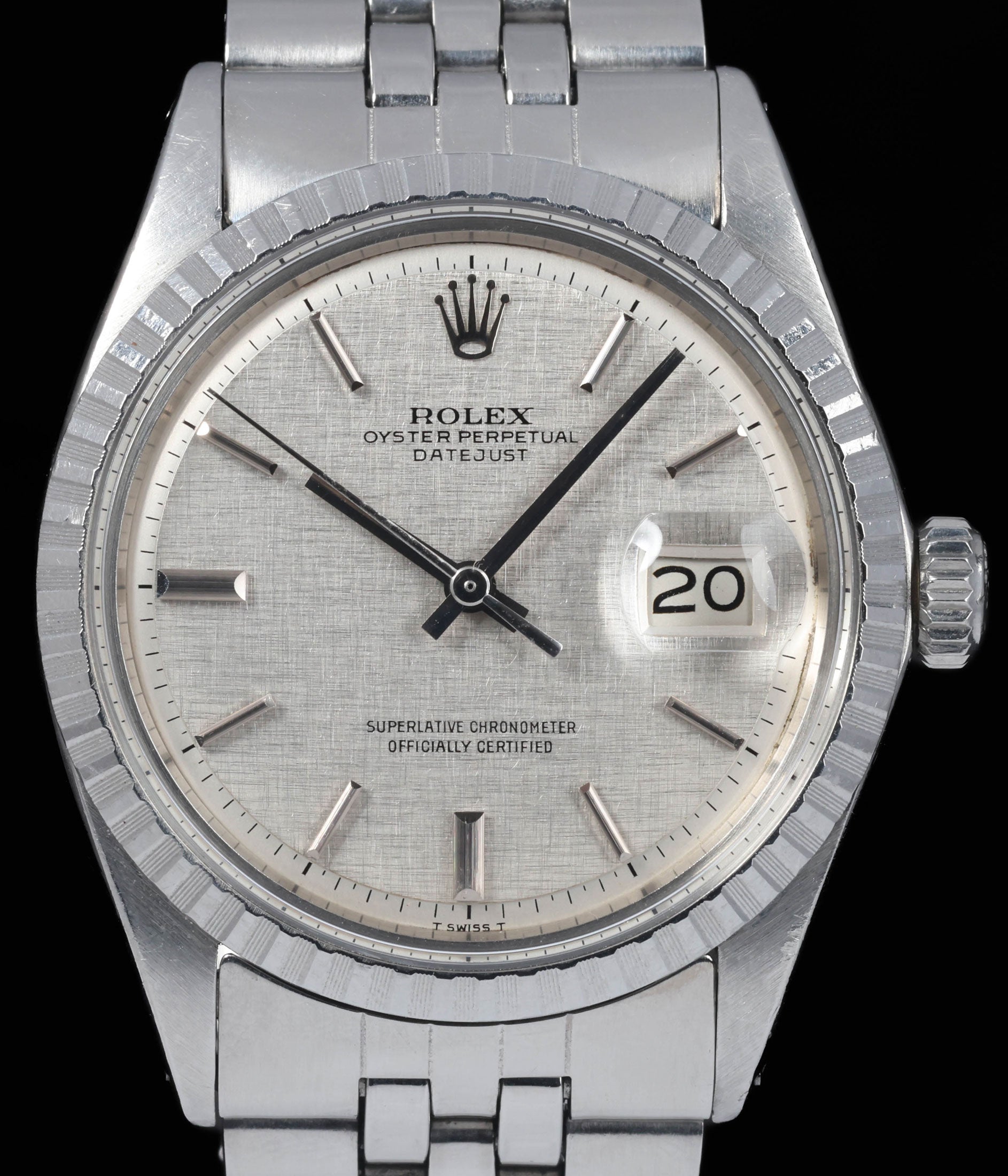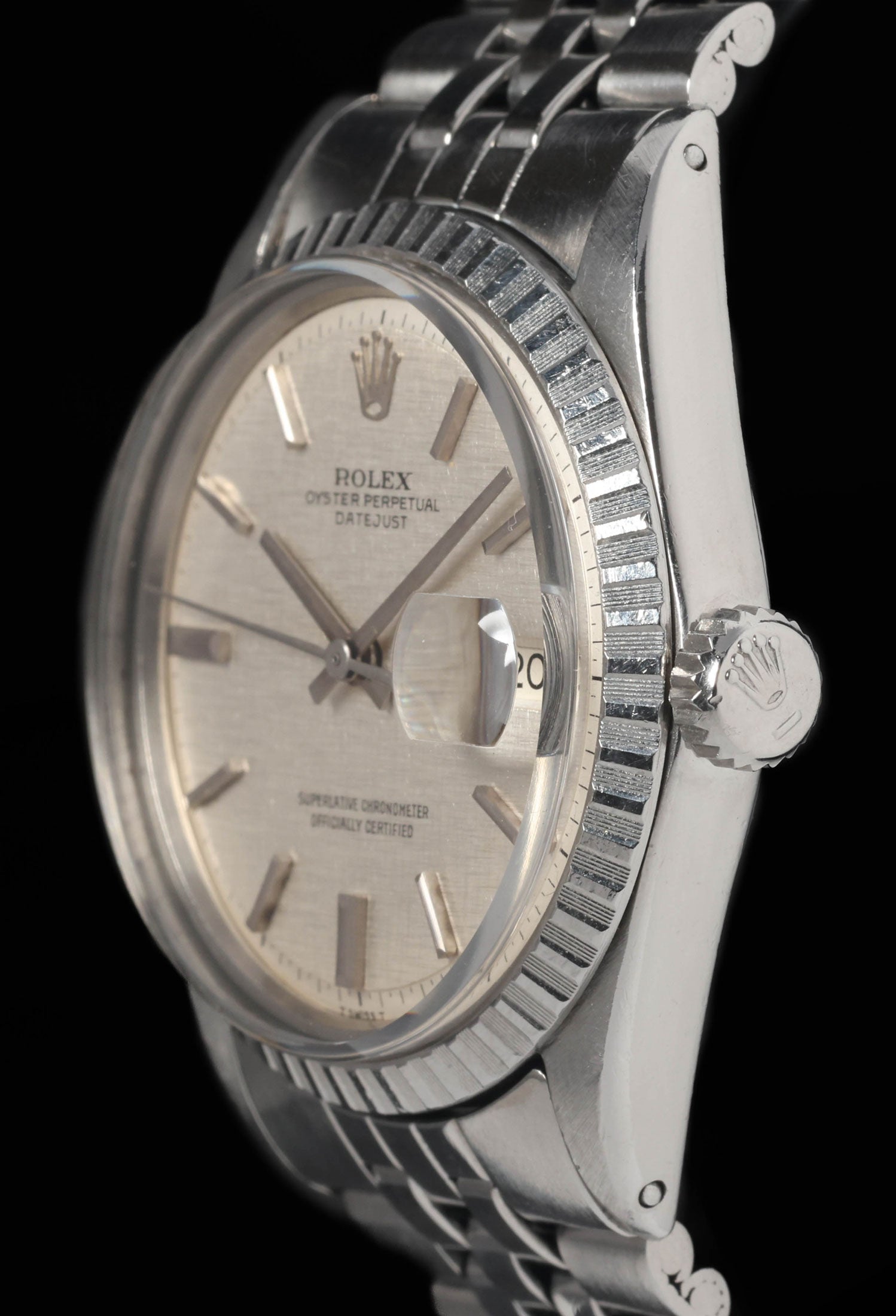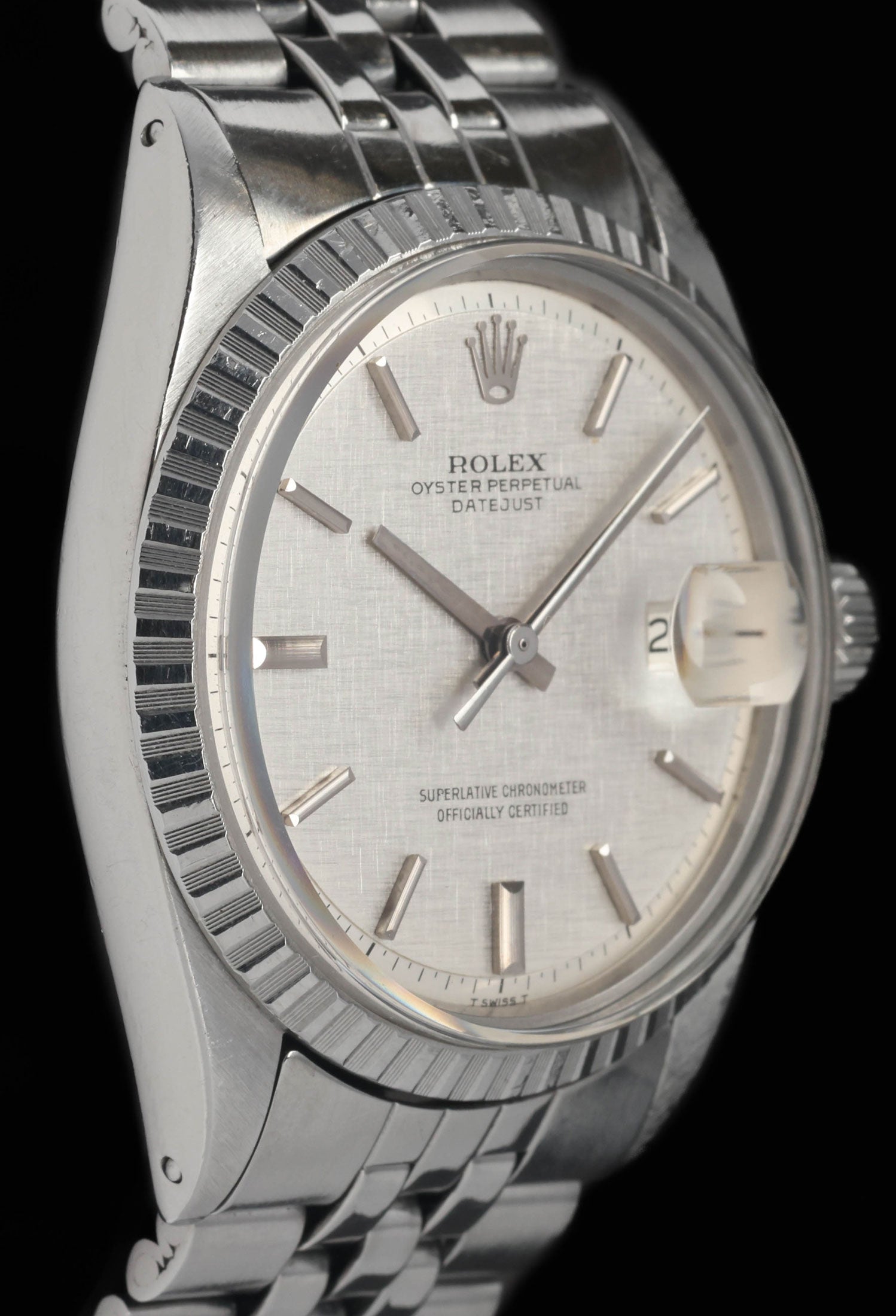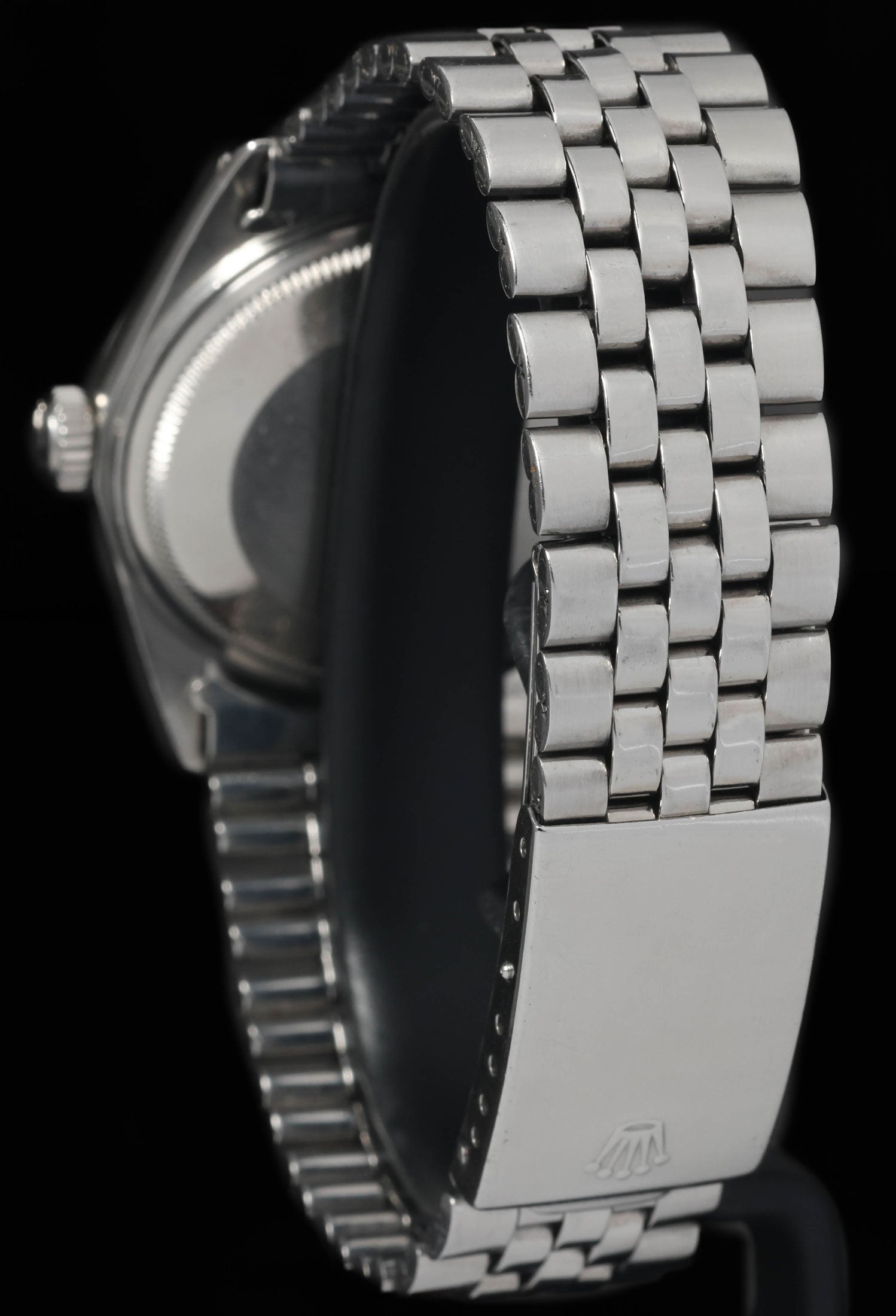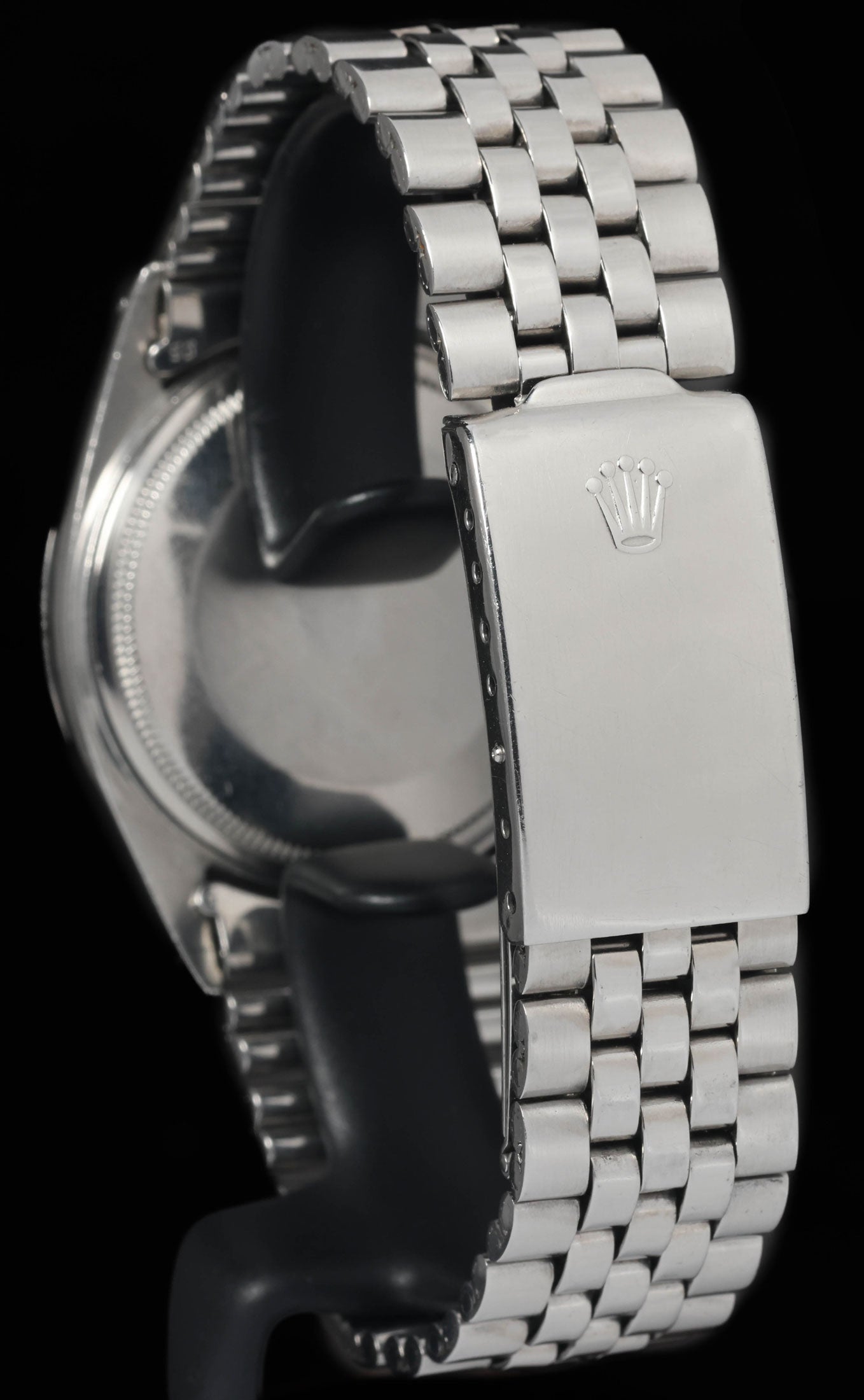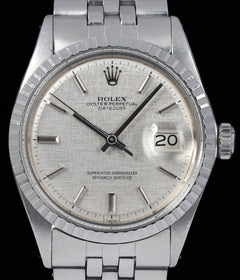Crown Vintage
Rolex Datejust 1603 'Linen-dial' 36mm 1973
Rolex Datejust 1603 'Linen-dial' 36mm 1973
Couldn't load pickup availability
Rolex Datejust 1603 'Linen-dial' 36mm 1973
The watch remains in great vintage condition with light hairlines visible on the case, consistent with careful wear. The engine-turned bezel retains sharp definition and presents well with minimal signs of age. The bracelet shows some stretch, typical for a watch of this era, but remains secure and comfortable on the wrist. The silver linen dial is in excellent condition, displaying crisp printing and no visible blemishes. The hands are in great condition with minor oxidation visible under close inspection, adding subtle vintage character. Overall, this is a well-preserved example that has aged gracefully while retaining strong visual appeal and originality.
Share
Why we love this watch
Why we love this watch
Rolex Datejust 1603 Linen Dial
Among the long line of Rolex Datejust references, the 1603 stands as one of the most versatile and understated. Introduced during a period when Rolex was refining the core of its Oyster Perpetual line, the 1603 combined the durability of stainless steel with the subtle sophistication of fine detailing. It shared much of its architecture with the 1601 but distinguished itself through its engine-turned bezel and a wide variety of dial executions. Among them, the silver linen dial variant has become one of the most elegant and recognisable.
Produced in the early 1970s, this reference features a small but fascinating detail. The dial is marked “Swiss T,” denoting tritium luminous material, yet it carries no lume plots at the hour markers. It is a quirk of Rolex dial production from an era when several dial makers supplied the brand and minor inconsistencies occurred. The absence of lume gives the dial a minimalist purity, allowing the linen texture to take visual prominence.
The Role of the Datejust 1603 in Rolex History
The reference 1603 formed part of Rolex’s celebrated 16xx series, which defined the Datejust throughout the 1960s and 1970s. Each reference within the family differed primarily by bezel design and metal composition. The 1600 featured a smooth steel bezel, the 1601 a fluted gold bezel, and the 1603 an engine-turned steel bezel with a distinctive rhythmic pattern. The 1603 therefore delivered an appearance that was slightly more utilitarian while maintaining the same elegance and precision expected of a Datejust.
During this era, Rolex positioned the Datejust as a refined, all-purpose chronometer that could move easily between professional and social settings. It was neither purely a sports model nor a dress watch, but rather a balanced design that embodied the brand’s philosophy of functionality and timeless design. The 1603 captured this duality perfectly. Its steel construction gave it resilience, while the decorative detailing of its bezel and dial added sophistication.
As the 1970s progressed, Rolex began modernising its manufacturing methods, but the 1603 retained the handcrafted elements that defined the brand’s mid-century identity. It represents one of the final expressions of the traditional Datejust before the arrival of sapphire crystals and quickset movements in the following decade.
Case and Proportions
The Oyster case of the 1603 measures 36 millimetres across, the same dimensions that have become synonymous with the Datejust line. The case construction follows Rolex’s proven formula of a solid monobloc middle case with a screw-down caseback and screw-down Twinlock crown. This engineering provided a water resistance rating of 100 metres when new, making the Datejust as robust as it was elegant.
The finish of the case is a study in contrast. The top surfaces of the lugs display a fine, linear brushing, while the case flanks are polished to a mirror finish. These alternating finishes accentuate the curvature of the lugs and add definition to the silhouette. Well-preserved examples retain the crisp transitions between these surfaces, while overpolished ones lose that precise geometry.
The defining feature of the 1603 is its engine-turned bezel. Crafted from stainless steel, it displays a series of finely milled ridges and polished notches that reflect light in a rhythmic pattern around the dial. The effect gives the watch energy and dimension, sitting between the plainness of the 1600’s smooth bezel and the luxurious gleam of the 1601’s gold fluting. The acrylic crystal with its Cyclops magnifier adds a gentle warmth that modern sapphire cannot replicate and reinforces the vintage character of the reference.
The Linen Dial
The linen dial is among the most distinctive textures Rolex ever produced. Instead of a smooth or sunburst finish, the surface features a crosshatched pattern pressed into the dial plate that resembles woven fabric. This texture interacts beautifully with light, alternating between matte and metallic reflections as the wrist moves. The effect is subtle yet striking and adds a tactile quality that sets the dial apart from standard finishes.
In this example, the dial is finished in a cool silver tone that complements the steel case. The applied baton hour markers and the polished Rolex coronet contrast against the textured background with crisp clarity. The framed date window at three o’clock aligns perfectly beneath the Cyclops lens and integrates seamlessly into the layout.
The most intriguing detail is the absence of lume plots. Despite the “Swiss T” signature indicating tritium, the dial shows no luminous material at the hour markers. This anomaly is a product of Rolex’s production practices of the time, when dials were sourced from several manufacturers and components were occasionally mixed across batches. Some dials were printed using templates intended for lumed configurations even when lume was omitted. The result is an unusually clean and symmetrical design that allows the linen texture to take full visual command.
Without lume plots, the dial achieves a purity rarely seen on other Datejust variants. The polished hour markers appear more prominent, and the absence of tritium dots enhances the sense of space and order. The combination of texture, symmetry and tone gives the watch a quiet sophistication that remains compelling today.
Hands and Dial Details
The hands are simple polished batons, proportioned precisely to match the applied indices. On this example, faint oxidation at their bases is visible under magnification, a natural and appealing sign of age. Originally, these hands would have contained small channels for tritium, but in keeping with the dial’s non-lumed configuration, the material is absent or no longer visible.
The printing on the dial reflects Rolex’s restrained approach. The upper half reads “Rolex Oyster Perpetual Datejust,” while the lower half carries “Superlative Chronometer Officially Certified.” The typography is evenly spaced and crisp, with the lower text curved slightly to follow the dial’s edge. These details exemplify Rolex’s precision in dial printing and contribute to the balanced composition that defines the model.
Movement and Technical Specifications
Inside the 1603 beats the calibre 1575, part of Rolex’s 1500-series family of automatic movements. The 1575 is renowned for its robustness and accuracy. It operates at 19,800 vibrations per hour, features 26 jewels, a bi-directional winding rotor, and a free-sprung balance with Microstella regulation.
The calibre 1575 drives the Datejust’s instant date-change mechanism, which advances the date precisely at midnight. Though the movement lacks a quickset function, the date can be adjusted by cycling the hands through 24-hour intervals. Its construction reflects the reliability and precision engineering that characterised Rolex’s mechanical development during this period.
Many later examples of the 1575 were equipped with a hacking seconds feature, allowing the seconds hand to stop when the crown is pulled out. The calibre is chronometer-certified and capable of maintaining accuracy well within COSC standards when properly serviced. Decades later, it remains one of the most respected movements in Rolex’s history, admired for its simplicity and resilience.
Bracelet Options and Wearability
The Datejust 1603 was most commonly fitted with the Jubilee bracelet, a five-link design introduced alongside the original Datejust in 1945. Constructed in folded stainless steel links, it offers flexibility and comfort. The alternating polished and brushed links provide a visual rhythm that complements the engine-turned bezel. Over time, these bracelets develop a distinctive suppleness, and while light stretch is common, well-preserved examples still feel solid and articulate.
Some 1603 models were supplied with the Oyster bracelet, which gives the watch a slightly sportier look. Both pairings are authentic to the reference and change the character of the watch subtly. The Jubilee enhances its refinement, while the Oyster emphasises its practicality.
The 36 millimetre case remains one of the most balanced proportions in watch design. It sits comfortably on a wide range of wrists, and the curved lugs allow the bracelet to drape naturally. The combination of brushed and polished surfaces, the crisp engine-turned bezel and the textured dial create layers of depth that reveal themselves under changing light.
The Dial’s Lume Anomaly
The presence of the “Swiss T” marking without any lume plots provides insight into Rolex’s production nuances during the 1970s. Dials were often produced in batches by suppliers such as Singer and Beyeler, and the “Swiss T” designation was sometimes applied to all dials from a production run, regardless of whether luminous material was actually used. This practice avoided the need to change printing plates for minor variations.
Another explanation is that certain markets or production batches called for non-lumed dials due to regulations or aesthetic preferences, yet they retained standard text for consistency. Whatever the reason, such details are part of the charm of vintage Rolex. They speak to an era when small irregularities resulted from human involvement in manufacturing rather than automated uniformity.
The absence of lume enhances the dial’s minimalist appeal. The interplay of brushed hour markers and the crosshatched texture creates enough contrast for legibility without relying on luminous material. Under bright light, the dial glows with a fine metallic sheen, while in low light, it settles into a soft grey tone that complements the polished case.
The 1603 in the Broader Datejust Family
The 1603 sits within a triad of references that define the vintage Datejust’s visual identity. The 1600 with its smooth bezel offered the simplest aesthetic, the 1601 with its fluted bezel introduced a touch of luxury, and the 1603 occupied the space between, providing texture and distinction without precious metal. All three shared the same calibre, case architecture and proportions, differing only in materials and minor details.
In practice, the 1603 delivers one of the most balanced interpretations of the Datejust. The steel bezel avoids the flashiness of gold while offering more visual interest than a polished surface. It is this balance that has helped the 1603 maintain strong appeal among collectors who prefer understated design paired with mechanical integrity.
The linen dial version adds further refinement. Its texture softens the otherwise sharp geometry of the case and bezel, creating a dialogue between industrial precision and organic surface detail. In this configuration, the 1603 feels at once classic and modern.
Evolution and Transitional Features
By the early 1970s, Rolex was approaching a shift toward more modern production. The 1575 movement represented the last of the non-quickset calibres, soon to be replaced by the 3035 in the late 1970s. Likewise, the acrylic crystal would eventually give way to sapphire, and folded-link bracelets would evolve into solid-link construction. The 1603 thus captures the final stage of Rolex’s vintage era, where traditional craftsmanship still played a central role.
Despite later technical improvements, many collectors regard the 1603 as the ideal intersection between old-world charm and mechanical reliability. It is a product of Rolex’s mature period, when precision engineering met careful hand-finishing. For daily wear, it remains one of the most satisfying vintage Rolex references thanks to its comfort, proportions and visual depth.
Aesthetic Balance and Modern Appeal
The 1603 with linen dial embodies the essence of timeless design. Every element contributes to harmony: the rhythmic bezel, the tactile dial, the crisp case geometry and the restrained typography. The dial’s absence of lume adds purity, and the fabric-like texture brings warmth to the steel exterior.
Under direct light, the crosshatch pattern comes alive, catching highlights along each line. Under softer lighting, the texture appears matte and understated. This ability to shift character is what gives the linen dial its enduring fascination. It rewards close observation and invites repeated attention without ostentation.
The 1603 remains a watch that communicates refinement through quiet details. In an age dominated by sports models and larger cases, its balanced proportions and subtle artistry feel more relevant than ever.
Final Thoughts
The Rolex Datejust 1603 with silver linen dial represents the peak of understated elegance in vintage Rolex design. It combines the proven reliability of the calibre 1575 with a case and bezel that exemplify Rolex’s mastery of proportion. The linen texture adds depth and individuality, while the rare “Swiss T” marking without lume plots introduces a note of intrigue that reminds collectors of the brand’s hand-crafted past.
As a whole, the watch captures the essence of the Datejust ideal: precision, versatility and quiet sophistication. It has presence without excess and charm without fragility. The 1603 endures not only as a reference of its time but as a statement of timeless design integrity. Its balance of form, function and texture continues to define what makes the Rolex Datejust a cornerstone of modern watchmaking.
Case & Bracelet
Case & Bracelet
Great vintage condition with light hairlines visible. The bracelet has some stretch consistent with age.
Dial & Hands
Dial & Hands
Dial and hands are in great condition with light oxidation on hands.
Warranty & Condition
Warranty & Condition
Crown Vintage Watches provides a minimum 3-month mechanical warranty on pre-owned watches, from the date of purchase.
The warranty covers mechanical defects only.
The warranty does not cover damages such as scratches, finish, crystals, glass, straps (leather, fabric or rubber damage due to wear and tear), damage resulting from wear under conditions exceeding the watch manufacturer’s water resistance limitations, and damage due to physical and or accidental abuse.
Please note, water resistance is neither tested nor guaranteed.
Shipping and insurance costs for warranty returns to us must be covered by the customer. Returns must be shipped via traceable courier. Return shipment must be pre-paid and fully insured. Collect shipping will be refused. In case of loss or damages, the customer is liable.
Our Pledge
At Crown Vintage Watches, we stand by the authenticity of every product we sell. For added peace of mind, customers are welcome to have items independently authenticated at their own expense.
Condition
Due to the nature of vintage timepieces, all watches are sold as is. We will accurately describe the current condition and working order of all watches we sell to the best of our ability.
Shipping & Refund
Shipping & Refund
